Efficient Terahertz Wide-Angle NUFFT-Based Inverse Synthetic Aperture Imaging Considering Spherical Wavefront
Abstract
:1. Introduction
2. Model and Methods
- Step one: Implement FFT to the domain of the raw data to get .
- Step two: Generate and implement FFT to its dimension to obtain .
- Step three: Multiple by ’s inverse filter to get .
- Step four: Implement IFFT to the dimension of to obtain .
- Step five: Transform the polar format data into Cartesian coordinates and reconstruct using IFFT.
3. Point Targets Simulations
3.1. Comparison of Imaging Results before and after Considering Spherical Wave Effect
3.2. Comparison of Imaging Quality
4. Experimental Results
4.1. Imaging Results
4.2. Computational Complexity Analyses
5. Conclusions
Acknowledgments
Author Contributions
Conflicts of Interest
References
- Tonouchi, M. Cutting-edge terahertz technology. Nat. Photonics 2007, 1, 97–105. [Google Scholar] [CrossRef]
- Appleby, R.; Wallace, H.B. Standoff Detection of Weapons and Contraband in the 100 GHz to 1 THz Region. IEEE Trans. Antennas Propag. 2007, 55, 2944–2956. [Google Scholar] [CrossRef]
- Essen, H.; Wahlen, A.; Sommer, R.; Johannes, W. High-bandwidth 220 GHz experimental radar. Electron. Lett. 2007, 43, 1114–1116. [Google Scholar] [CrossRef]
- Danylov, A.A.; Goyette, T.M.; Waldman, J.; Coulombe, M.J.; Gatesman, A.J.; Giles, R.H.; Qian, X.; Chandrayan, N.; Vangala, S.; Termkoa, K.; et al. Terahertz inverse synthetic aperture radar (ISAR) imaging with a quantum cascade laser transmitter. Opt. Express 2010, 18, 16264–16272. [Google Scholar] [CrossRef] [PubMed]
- Mencia-Oliva, B.; Grajal, J.; Badolato, A. 100-GHz FMCW Radar Front-End for ISAR and 3D Imaging. In Proceedings of the IEEE Radar Conference (RadarCon), Kansas City, MO, USA, 23–27 May 2011; pp. 389–392.
- Liang, M.Y.; Zhang, C.L.; Zhao, R.; Zhao, Y.J. Experimental 0.22 THz Stepped Frequency Radar System for ISAR Imaging. J. Infrared Millim. Terahertz Waves 2014, 35, 780–789. [Google Scholar] [CrossRef]
- Sadjadi, F.A. New experiments in inverse synthetic aperture radar image exploitation for maritime surveillance. Proc. SPIE Def. Secur. 2014, 9090. [Google Scholar] [CrossRef]
- Sadjadi, F. New comparative experiments in range migration mitigation methods using polarimetric inverse synthetic aperture radar signatures of small boats. In Proceedings of the International Radar Conference (Radar), Lille, France, 13–17 October 2014; pp. 613–616.
- Stanko, S.; Caris, M.; Wahlen, A.; Sommer, R.; Wilcke, J.; Leuther, A.; Tessmann, A. Millimeter Resolution with Radar at Lower Terahertz. In Proceedings of the 14th International Radar Symposium (IRS), Dresden, Germany, 19–21 June 2013; pp. 235–238.
- Cheng, B.; Jiang, G.; Wang, C.; Yang, C.; Cai, Y.; Chen, Q.; Huang, X.; Zeng, G.; Jiang, J.; Deng, X.; Zhang, J. Real-Time Imaging with a 140 GHz Inverse Synthetic Aperture Radar. IEEE Trans. Terahertz Sci. Technol. 2013, 3, 594–605. [Google Scholar] [CrossRef]
- Desai, M.D.; Jenkins, W.K. Convolution backprojection image reconstruction for spotlight mode synthetic aperture radar. IEEE Trans. Image Proc. 1992, 1, 505–517. [Google Scholar] [CrossRef] [PubMed]
- Carrara, W.G.; Goodman, R.S.; Majewski, R.M. Spotlight Synthetic Aperture Radar: Signal Processing Algorithms; Artech House: Norwood, MA, USA, 1995. [Google Scholar]
- Doerry, A.W. Synthetic aperture radar processing with polar formatted subapertures. In Proceedings of the 28th Asilomar Conference on Signals, Systems and Computers, Pacific Grove, CA, USA, 30 October–2 November 1994; pp. 1210–1215.
- Doren, N.E.; Jakowatz, C.V.; Wahl, D.E.; Thompson, P.A. General formulation for wavefront curvature correction in polar-formatted spotlight-mode SAR images using space-variant post-filtering. In Proceedings of the Sixth International Conference on Image Processing and Its Applications, Dublin, Ireland, 14–17 July 1997; pp. 861–864.
- Zelnio, E.G. Space-variant filtering for correction of wavefront curvature effects in spotlight-mode SAR imagery formed via polar formatting. In Proceedings of the SPIE—International Society for Optical Engineering, San Diego, CA, USA, 30 July–1 August 1997; pp. 33–42.
- Carrara, W.G.; Goodman, R.S.; Ricoy, M.A. New algorithms for widefield SAR image formation. In Proceedings of the IEEE National Radar Conference, Philadelphia, PA, USA, 26–29 April 2004; pp. 38–43.
- Yan, W.; Xu, J.D.; Li, N.J.; Tan, W. A Novel Fast Near-Field Electromagnetic Imaging Method for Full Rotation Problem. Prog. Electromagn. Res. 2011, 120, 387–401. [Google Scholar] [CrossRef]
- Olivadese, D.; Giusti, E.; Berizzi, F.; Martorella, M. Near field 3D circular SAR imaging. In Proceedings of the International Asia-Pacific Conference on Synthetic Aperture Radar, Seoul, Korea, 26–30 September 2011; pp. 1–4.
- Zhang, B.; Pi, Y.; Min, R. A near-field 3D circular sar imaging technique based on spherical wave decomposition. Prog. Electromagn. Res. 2013, 141, 327–346. [Google Scholar] [CrossRef]
- Bryant, M.L.; Gostin, L.L.; Soumekh, M. 3-D E-CSAR imaging of a T-72 tank and synthesis of its SAR reconstructions. IEEE Trans. Aerosp. Electron. Syst. 2003, 39, 211–227. [Google Scholar] [CrossRef]
- Berizzi, F.; Corsini, G. A new fast method for the reconstruction of 2-D microwave images of rotating objects. IEEE Trans. Image Proc. 1999, 8, 679–687. [Google Scholar] [CrossRef] [PubMed]
- Vaupel, T.; Eibert, T.F. Comparison and application of near-field ISAR imaging techniques for far-field Radar cross section determination. IEEE Trans. Antennas Propag. 2006, 54, 144–151. [Google Scholar] [CrossRef]
- Broquetas, A.; Palau, J.; Jofre, L.; Cardama, A. Spherical wave near-field imaging and radar cross-section measurement. IEEE Trans. Antennas Propag. 1998, 46, 730–735. [Google Scholar] [CrossRef]
- Li, S.; Sun, H.; Zhu, B.; Liu, R. Two-Dimensional NUFFT-Based Algorithm for Fast Near-Field Imaging. IEEE Antennas Wirel. Propag. Lett. 2010, 9, 814–817. [Google Scholar] [CrossRef]
- Harrington, R.F. Time-Harmonic Electromagnetic Fields. Siam J. Math. Anal. 1961, 29, 395–423. [Google Scholar]
- Greengard, L.; Lee, J.Y. Accelerating the Nonuniform Fast Fourier Transform. Siam Rev. 2004, 46, 443–454. [Google Scholar] [CrossRef]
- Gao, J.; Qin, Y.; Deng, B.; Wang, H.Q.; Li, J.; Li, X. Terahertz Wide-Angle Imaging and Analysis on Plane-Wave Criteria Based on Inverse Synthetic Aperture Techniques. J. Infrared Millim. Terahertz Waves 2016, 37, 373–393. [Google Scholar] [CrossRef]
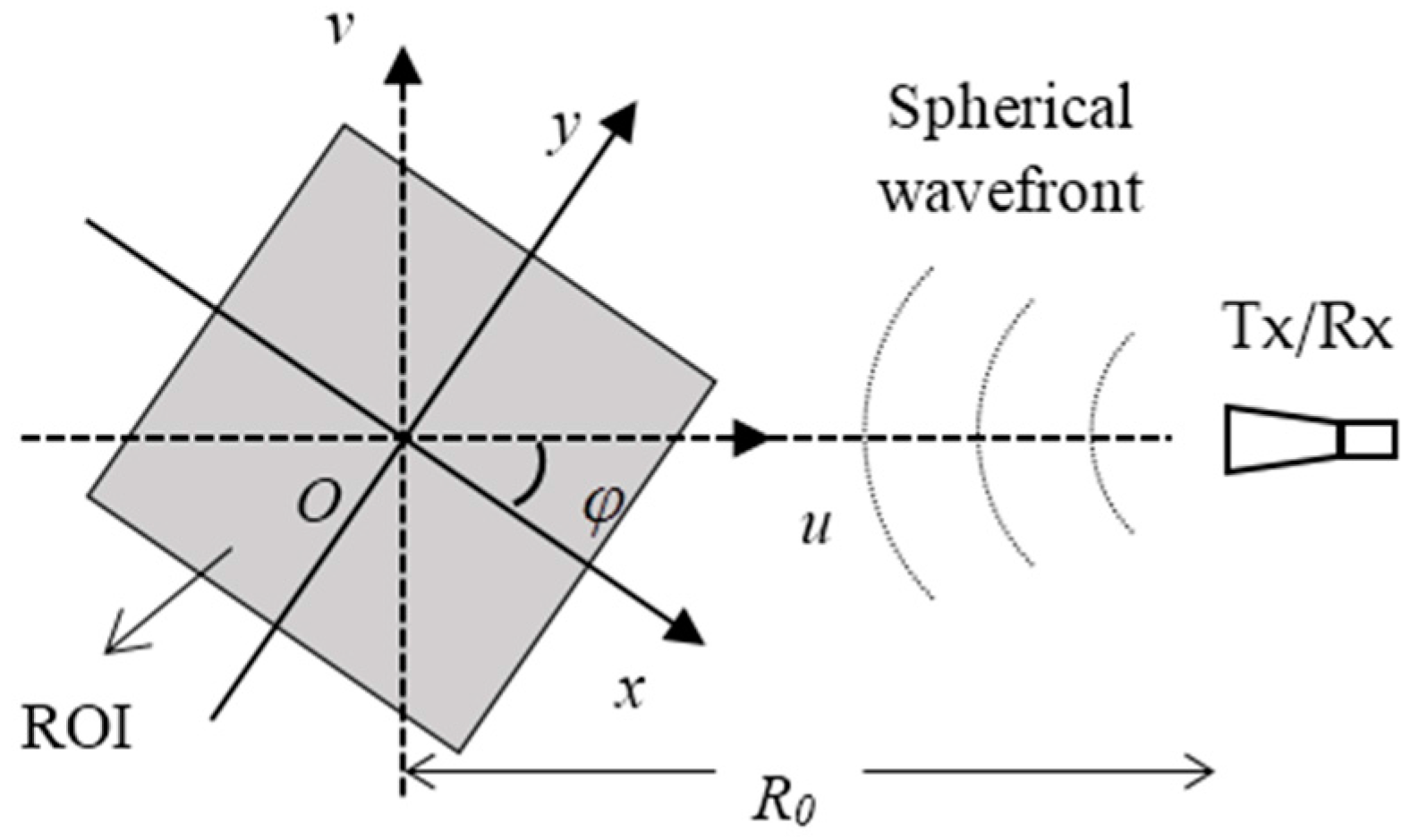
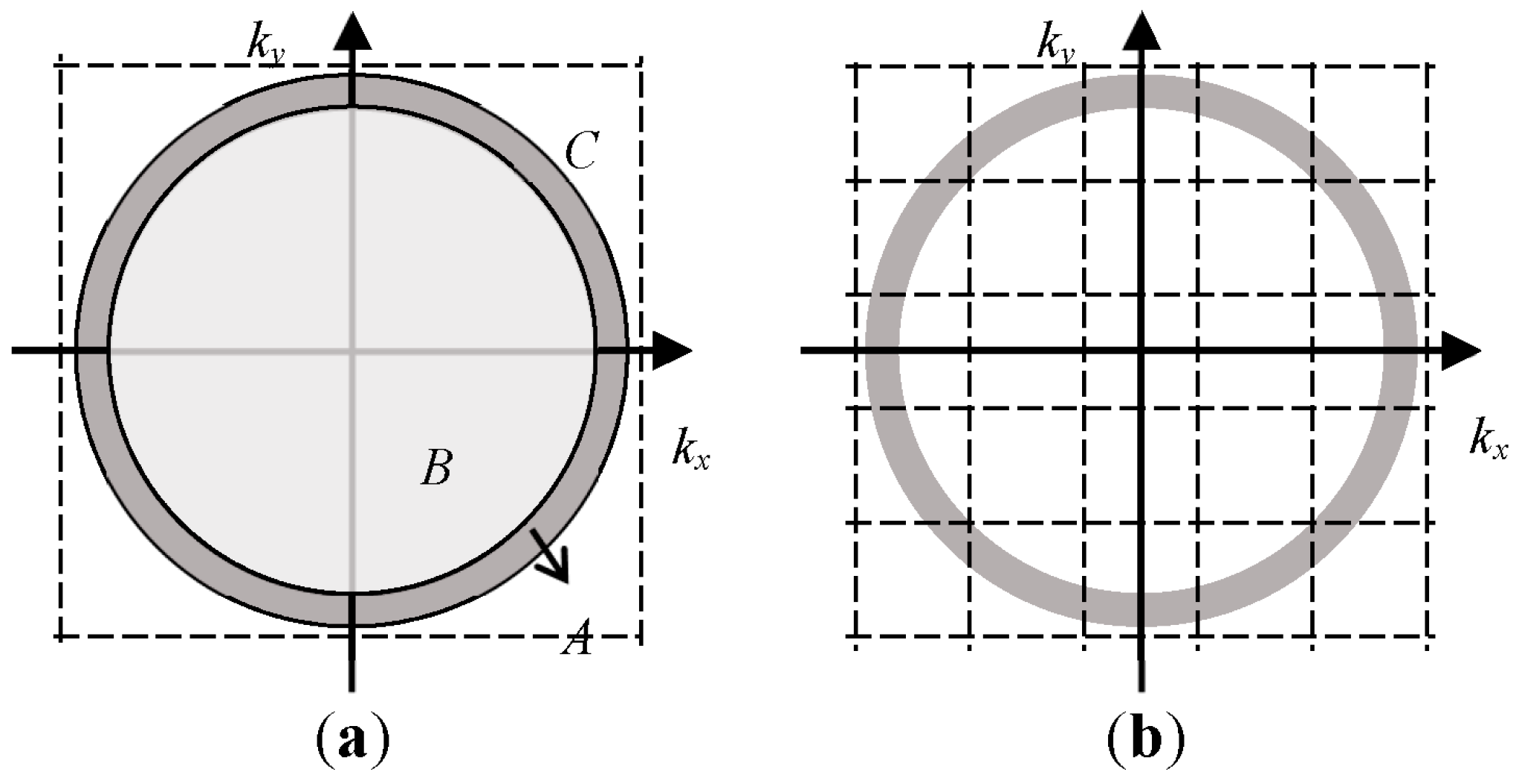
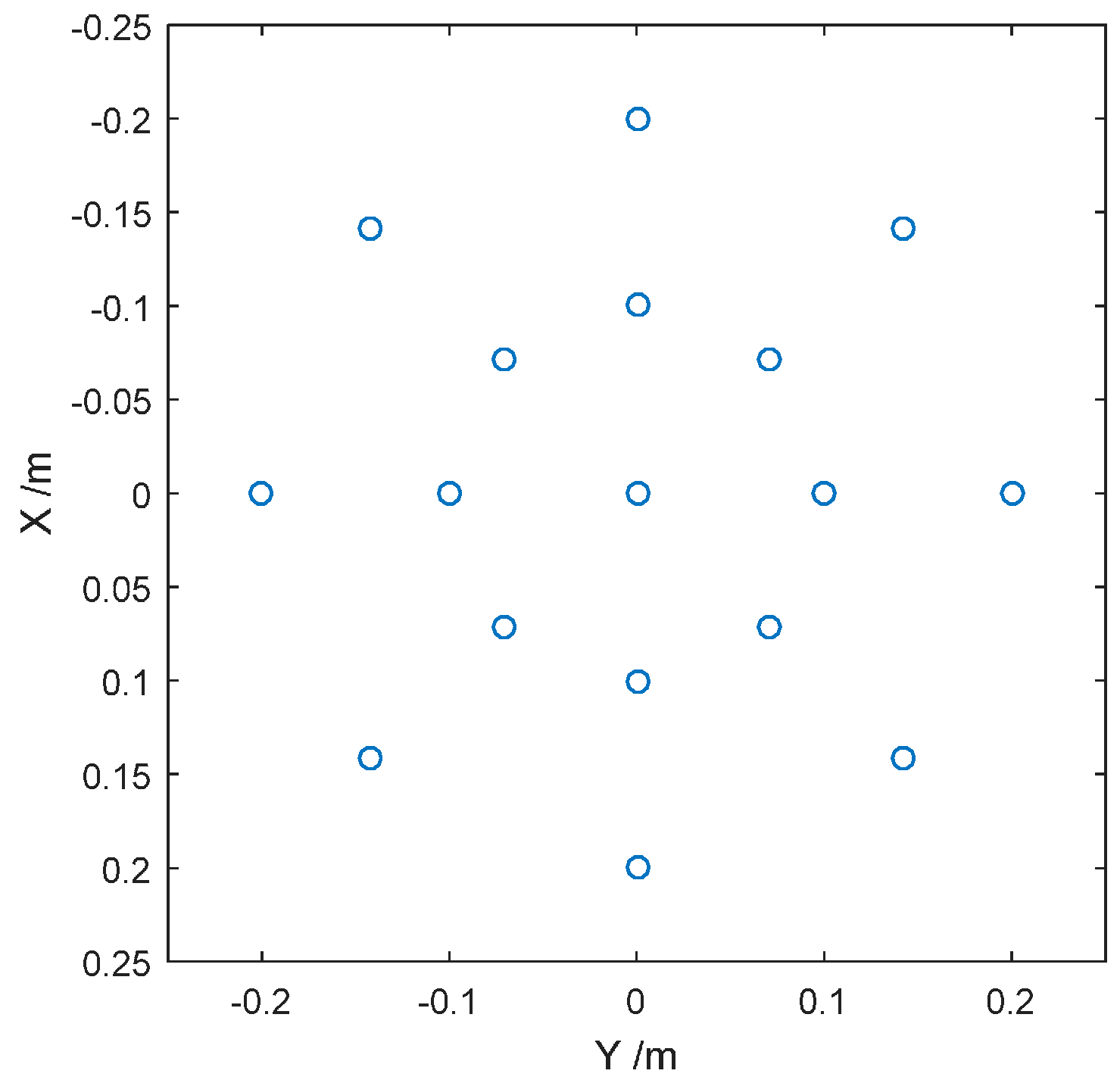
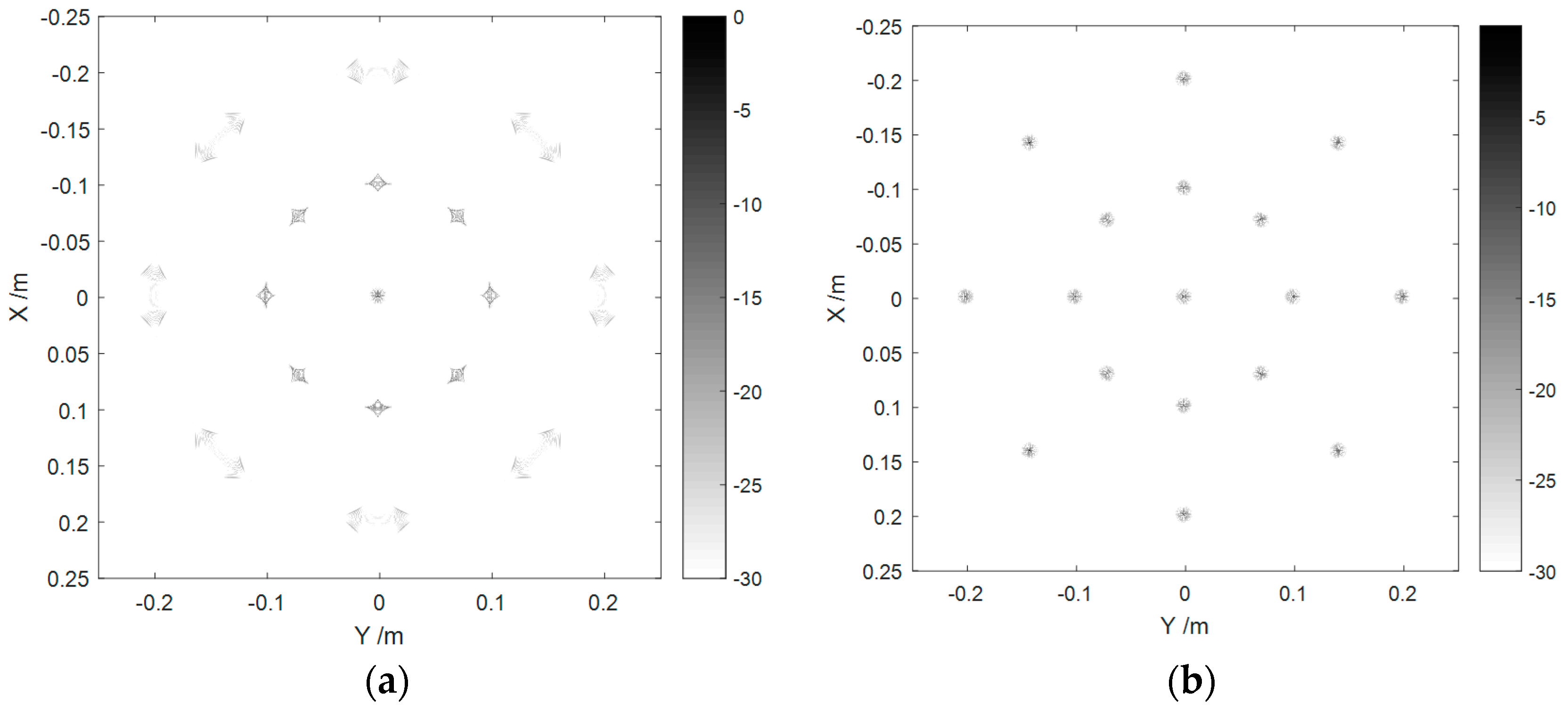

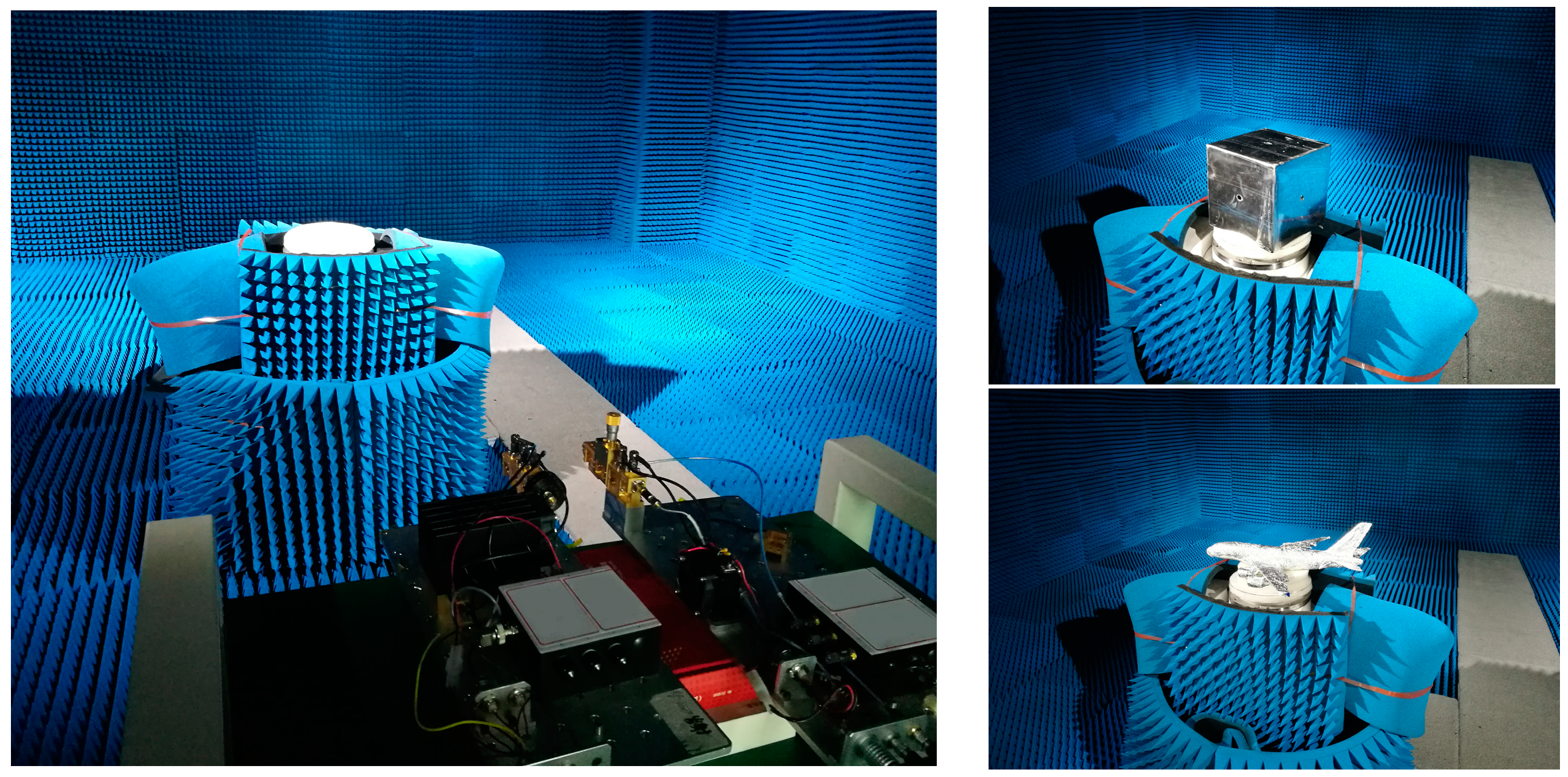
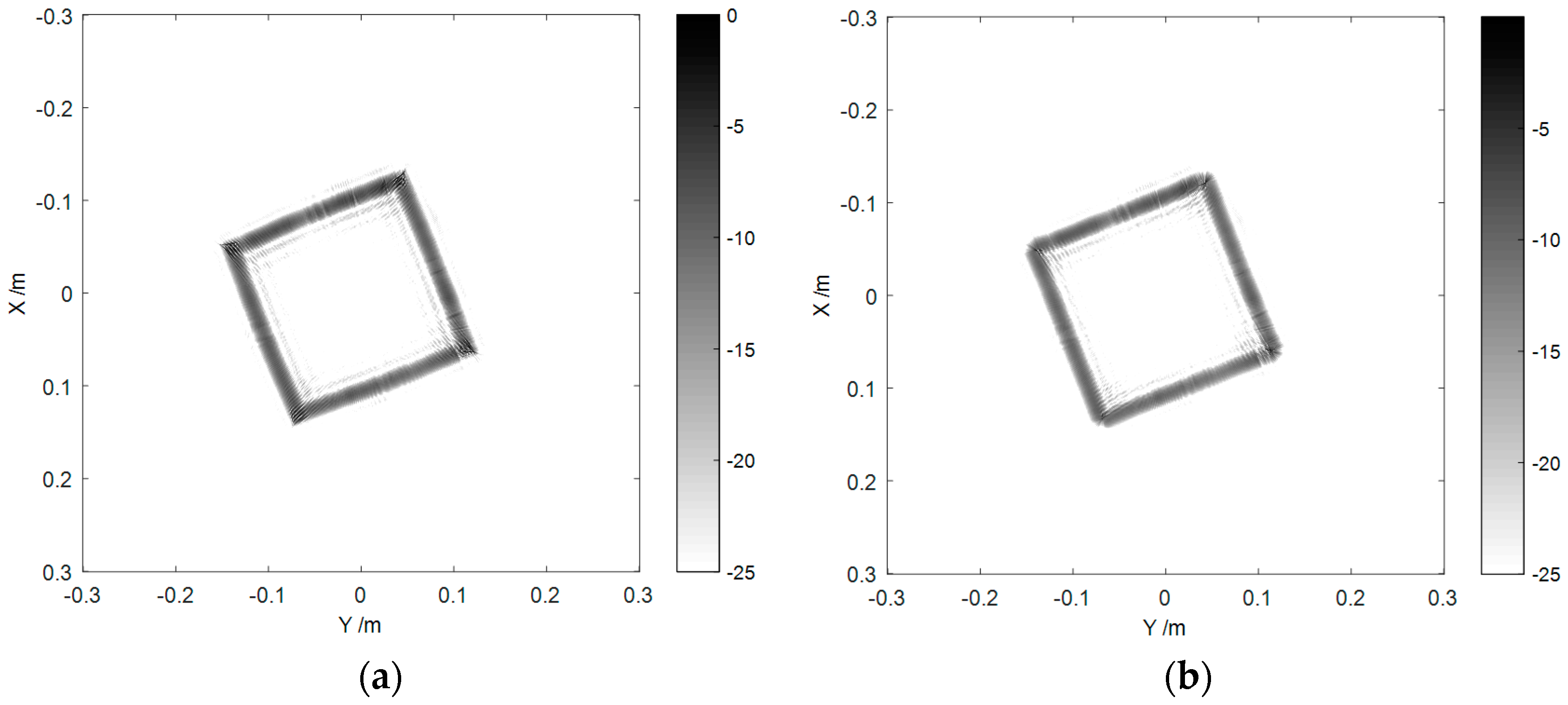


| Center Frequency | Bandwidth | Region of Imaging (ROI) | |||
|---|---|---|---|---|---|
| 1 m | 360° | 0.0225° | 220 GHz | 12.8 GHz | 0.5 × 0.5 m2 |
| Operations | Computational Complexity |
|---|---|
| Spherical wavefront compensation | |
| FGG [26] | |
| 2D-IFFT |
| Operations | Computational Complexity |
|---|---|
| FFT in range direction | |
| Spherical interpolation and coherent summation along azimuth angle |
© 2016 by the authors; licensee MDPI, Basel, Switzerland. This article is an open access article distributed under the terms and conditions of the Creative Commons Attribution (CC-BY) license (http://creativecommons.org/licenses/by/4.0/).
Share and Cite
Gao, J.; Deng, B.; Qin, Y.; Wang, H.; Li, X. Efficient Terahertz Wide-Angle NUFFT-Based Inverse Synthetic Aperture Imaging Considering Spherical Wavefront. Sensors 2016, 16, 2120. https://doi.org/10.3390/s16122120
Gao J, Deng B, Qin Y, Wang H, Li X. Efficient Terahertz Wide-Angle NUFFT-Based Inverse Synthetic Aperture Imaging Considering Spherical Wavefront. Sensors. 2016; 16(12):2120. https://doi.org/10.3390/s16122120
Chicago/Turabian StyleGao, Jingkun, Bin Deng, Yuliang Qin, Hongqiang Wang, and Xiang Li. 2016. "Efficient Terahertz Wide-Angle NUFFT-Based Inverse Synthetic Aperture Imaging Considering Spherical Wavefront" Sensors 16, no. 12: 2120. https://doi.org/10.3390/s16122120
APA StyleGao, J., Deng, B., Qin, Y., Wang, H., & Li, X. (2016). Efficient Terahertz Wide-Angle NUFFT-Based Inverse Synthetic Aperture Imaging Considering Spherical Wavefront. Sensors, 16(12), 2120. https://doi.org/10.3390/s16122120






